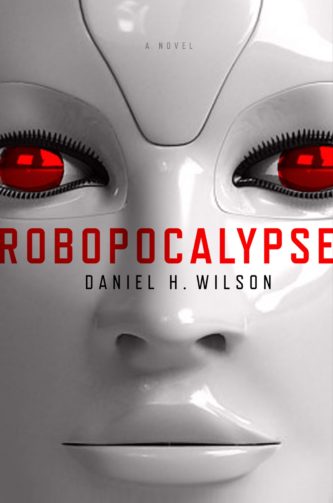 By DANIEL H. WILSON (Doubleday; 2011)
By DANIEL H. WILSON (Doubleday; 2011)
I didn’t think much of this inexplicably popular take on one of science fiction’s widely utilized clichés. As I’m sure we’re all aware, it’s a longtime sci-fi requisite that one day machines will turn on their creators and destroy civilization, which has been the subject of many a book, story, TV episode, video game and movie. The one thing ROBOPOCALYPSE has in its favor is the fact that its author, unlike those of previous robot uprising accounts, didn’t have to invent a computerized future setting for his story, as our current technology-besotted reality is disturbingly suitable for a robopocalypse. Otherwise, though, ROBOPOCALYPSE falls short.
The book’s overall layout resembles that of Max Brooks’ WORLD WAR Z (ROBOPOCALYPSE actually followed a book called HOW TO SURVIVE A ROBOT UPRISING, which seems to have been patterned on Brooks’ ZOMBIE SURVIVAL GUIDE), taking the form of an informal inquest into a robotic apocalypse. Several human characters are introduced, among them a young fast food worker named Jeff who’s attacked by a robot servant; Takeo Nomura, an ageing bachelor menaced by his own beloved sex doll; Mathilda, a young girl whose “baby-comes-alive” dolly unexpectedly begins talking to her one day, saying some pretty upsetting things; and Cormac Wallace, a Bostonian driven from his hometown to the Gray Horse Indian Reservation, which becomes a focal point of the anti-robot resistance. Wallace, I should add, provides the framing device, having found a cube that reveals to him the history of the “new war.”
The source of all the mayhem is Archos, a sentient robot who kills his creator just as the latter is ready to shut Archos down. Archos, it seems, has misunderstood its purpose, believing it, in concert with mankind, exists only to wreak destruction. Archos follows through on that resolution, resulting in “Zero Hour,” in which cars come to life to mow down their owners, planes crash themselves and electricity around the world abruptly cuts out. It’s up to Wallace and his fellow human survivors to fight back against the robot menace.
ROBOPOCALYPSE is a clever and fast-moving concoction. The author, who has a PhD in robotics, doesn’t bludgeon us with technical detail, keeping the focus on human concerns throughout. Yet the book doesn’t quite hold together story-wise; the multi-narrator epistolary format may have worked in WORLD WAR Z, which functioned more as a faux history than a thriller, but here, in a book that does seek to thrill its readers, it only serves to further dilute an already sluggish narrative.
Furthermore, there’s the fact that, simply, ROBOPOCALYPSE feels tired. It’s possible that if I weren’t already familiar with WAR OF THE WORLDS, I ROBOT, DO ANDROIDS DREAM OF ELECTRIC SHEEP?, THE TERMINATOR and dozens of other robot-themed entertainments I might have enjoyed this novel more, but I am familiar with those books and movies, in whose wake ROBOPOCALYPSE is but a pale shadow.
